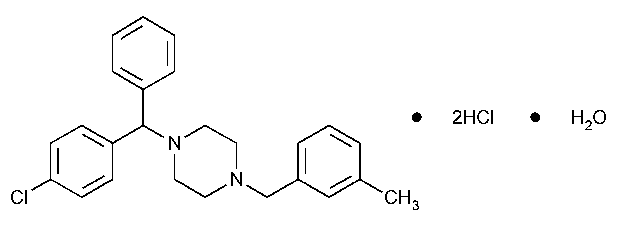Meclizine Hydrochloride
Piperazine,1-[(4-chlorophenyl)phenylmethyl]-4-[(3-methylphenyl)methyl]-,dihydrochloride,monohydrate.
1-(p-Chloro-a-phenylbenzyl)-4-(m-methylbenzyl)piperazine dihydrochloride monohydrate [31884-77-2].
Anhydrous 463.88 [1104-22-9].
»Meclizine Hydrochloride contains not less than 97.0percent and not more than 100.5percent of C25H27ClN2·2HCl,calculated on the anhydrous basis.
Packaging and storage—
Preserve in tight containers.
Identification—
A:
Infrared Absorption á197Kñ.
Solution:
10µg per mL.
Medium:
dilute hydrochloric acid (1in 100).
C:
Dissolve 25mg in a mixture of 3mLof 2Nnitric acid and 5mLof alcohol:the solution responds to the tests for Chloride á191ñ.
Water,Method Iá921ñ:
not more than 5.0%.
Residue on ignition á281ñ:
not more than 0.1%.
Chromatographic purity—
Mobile phase—
Dissolve 1.5g of sodium 1-heptanesulfonate in 300mLof water,and mix this solution with 700mLof acetonitrile.Adjust with 0.1Nsulfuric acid to a pHof 4,filter,and degas.Make adjustments if necessary (see System Suitabilityunder Chromatography á621ñ).
Standard solution—
Dissolve an accurately weighed quantity of USP Meclizine Hydrochloride RSin Mobile phase,and dilute quantitatively,and stepwise if necessary,with Mobile phaseto obtain a solution having a known concentration of about 2.5µg per mL.
Test solution—
Prepare a solution of Meclizine Hydrochloride in Mobile phasehaving a known concentration of about 0.5mg per mL.
System suitability solution—
Prepare a solution in Mobile phasecontaining about 0.01mg of USP Meclizine Hydrochloride RSand 0.01mg of 4-chlorobenzophenone per mL.
Chromatographic system
(see Chromatography á621ñ)—The liquid chromatograph is equipped with a 230-nm detector and a 4.6-mm ×25-cm column that contains 10-µm packing L1.The flow rate is about 1.3mLper minute.Chromatograph the System suitability solution,and record the peak responses as directed for Procedure:the relative retention times are about 0.8for meclizine hydrochloride and 1.0for 4-chlorobenzophenone;and the resolution,R,between the 4-chlorobenzophenone and meclizine hydrochloride peaks is not less than 2.0.Chromatograph the Standard solution,and record the peak responses as directed for Procedure:the tailing factor for the analyte peak is not more than 1.5;the column efficiency,N,determined from the analyte peak is not less than 1800theoretical plates;and the relative standard deviation for replicate injections is not more than 1.5%.
Procedure—
Separately inject equal volumes (about 20µL)of the Standard solutionand the Test solutioninto the chromatograph.Allow the Test solutionto elute for not less than three times the retention time of meclizine hydrochloride.Record the chromatograms and measure all of the peak areas:the sum of the peak responses,excluding that of meclizine hydrochloride,from the Test solutionis not more than two times the meclizine hydrochloride response from the Standard solution(1.0%),and no single peak response is greater than that of the meclizine hydrochloride response from the Standard solution(0.5%).
Organic volatile impurities,Method IVá467ñ:
meets the requirements.
Assay—
Dissolve about 350mg of Meclizine Hydrochloride,accurately weighed,in about 50mLof chloroform.Add 50mLof glacial acetic acid,5mLof acetic anhydride,and 10mLof mercuric acetate TS,and titrate with 0.1Nperchloric acid VS,determining the endpoint potentiometrically,using a calomel-glass electrode system (see Titrimetry á541ñ).Perform a blank determination,and make any necessary correction.Each mLof 0.1Nperchloric acid is equivalent to 23.19mg of C25H27ClN2·2HCl.
Auxiliary Information—
Staff Liaison:Elena Gonikberg,Ph.D.,Scientist
Expert Committee:(PA4)Pharmaceutical Analysis 4
USP28–NF23Page 1193
Phone Number:1-301-816-8251
